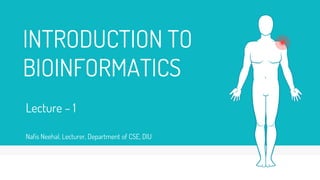
Lecture 1
- 1. INTRODUCTION TO BIOINFORMATICS Lecture – 1 Nafis Neehal, Lecturer, Department of CSE, DIU
- 2. CONTENTS 1. Basics - Cell - Nucleus - Chromosome - DNA - RNA - Gene - Genome 2. Brief History 3. Present and Future Scopes
- 3. 1. Begin With Basics Let’s start with the very basics and learn step by step, TOGETHER!
- 4. CELL ▹Cell Types – • Prokaryote – no nucleus or membrane-bounded organelles. Ex- Bacteria • Eukaryote – have nucleus and other membrane- bounded organelles. Ex- Human ▹Cell Contents - • Mitochondria – Power House of Cell • Lysosomes – Holds enzymes created by a cell • Golgi Apparatus (body) – Processes protein and lipids • Endoplasmic Reticulum – Involved in protein and lipid synthesis • Nucleus – Brain of the cell • Cytoplasm – liquid inside cell where organelles float
- 5. NUCLEUS • Nuclear membrane – 2 layered membrane • Nucleolus – dense object inside nucleus • Chromatin – Packed inside the nucleus of every human cell is nearly 6 feet of DNA, which is divided into 46 individual molecules, one for each chromosome and each about 1.5 inches long. 23 pairs of chromosome, 22 pairs of common autosome, 1 pair sex chromosome • Nucleoplasm – dense liquid inside nucleus
- 6. Chromosome
- 7. NUCLEIC ACID (DNA & RNA)
- 8. GENE • A gene is the basic physical and functional unit of heredity. • Portion of DNA which acts as instruction to make proteins. • Human gene can have few hundred to 2 million base pairs. • The Human Genome Project has estimated that humans have between 20,000 and 25,000 genes. • Every person has two copies of each gene, one inherited from each parent. • Most genes are the same in all people, but a small number of genes (less than 1 percent of the total) are slightly different between people (called allele). • These small differences contribute to each person’s unique physical features.
- 9. GENOME • A genome is an organism’s complete set of DNA, including all of its genes. • Each genome contains all of the information needed to build and maintain that organism. • In humans, a copy of the entire genome—more than 3 billion DNA base pairs—is contained in all cells that have a nucleus.
- 10. 2. HISTORY A Journey from Biology to Bioinformatics
- 11. WHAT IS BIOINFORMATICS? ▹The applications of computer sciences to molecular biology in particular to the study of macromolecules such as proteins and nucleic acids. ▹Bringing biological themes to computers
- 12. ” SYNONYMS Molecular Bioinformatics, Computational Biology, Biocomputing
- 13. FROM BIOLOGY TO BIOINFORMATICS ▹From Academic Interest to Commercial Interest ▹From Knowledge Discovery to Industrial Development ▹Added Pursuit for Longer Life and Cure for Diseases ▹Tremendous recent progress in Biology and Engineering
- 14. ▹ Completed between 1986 to April 2003 ▹ Identify all genes of Human DNA ▹ Around 3 Billion Nucleutide Bases (A, T, G, C) in a human body ▹ Average gene consists 3000 bases, varies in size (Largest Gene – 2.4 Million Bases) ▹ Total Number of Genes around 30,000 ▹ Functions are unknown of almost 50% discovered genes HUMAN GENOME PROJECT
- 15. 3. BIOINFORMATICS – PRESENT & FUTURE SCOPES What’s happening now and what might happen in the upcoming years?
- 16. SCOPE OF RESEARCH Sequence Alignment Arranging DNA/RNA/Protein Sequences to identify regions of similarity. Genome Assembly Merging long/short reads by aligning and produce original ancestral gene. Read Mapping Mapping generated long/short reads to a reference sequence. Evolution Phylogenetics Studying evolutionary relationships among bilogical entities. Statistical Phylogenetics Performing statistical analysis for finding evolutionary relationships between biological entities. Population Genetics Study of genetic variation within populations.
- 17. SCOPE OF RESEARCH (CONT.) Genome Annotation Process of identifying location of genes and all other coding regions in a genome. Gene Expression Analysis Gene expression analysis is the process by which information from a gene is used in the synthesis of a functional gene product. Computer Aided Drug (CAD) Design Designing new medications with knowledge of a biological target and with help of computer tools. Structure Prediction (RNA, Protein) Predicting 3D structures of RNA and Protein. Association Mapping Linkage Analysis and disequilibrium mapping. Basically links phenotypes with genotypes. Systems Biology Study of systems of biological components.
- 19. 70 Miles per Hour Nerve Impulses run to and from Brain 20% Oxygen Brain uses 20% of Oxygen entered into the blood 5x Times Brain’s storage capacity compared to Encyclopedia Britannica 80% Water Human brain has 80% water
- 20. CURIOUS?
- 21. ▹ Cell Structure - https://www.youtube.com/watch?v=URUJD5NEXC8 Youtube Links